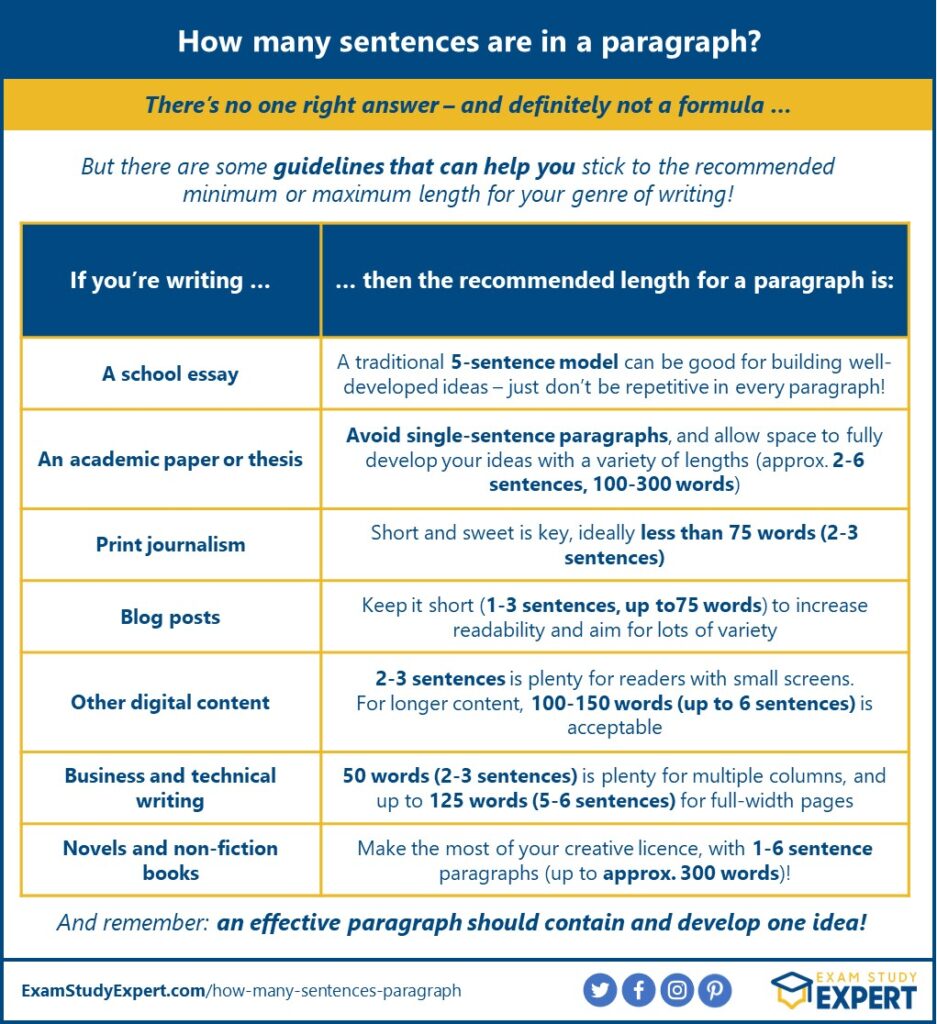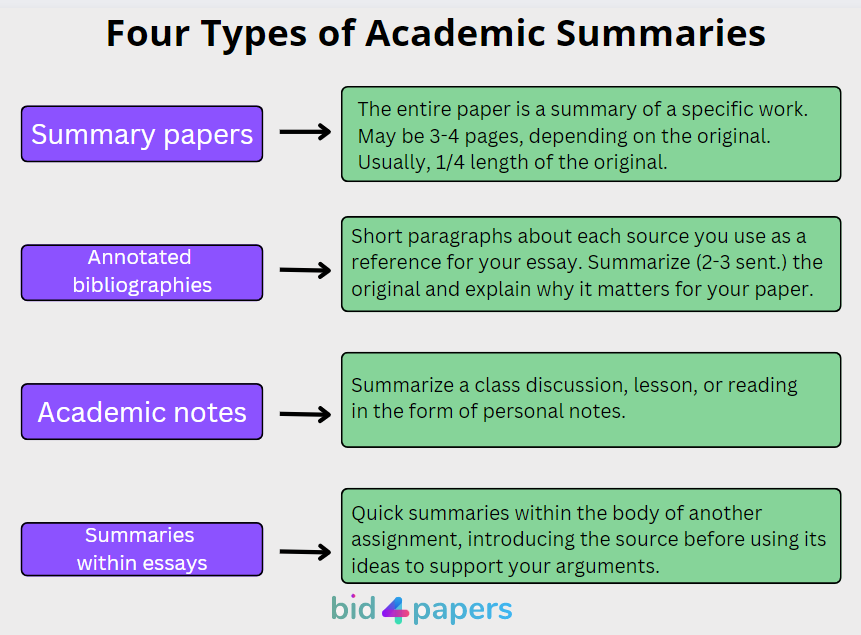How Many Paragraphs are in a Summary
A summary typically consists of 3 to 5 paragraphs. The number of paragraphs in a summary depends on the length and complexity of the original text.
A concise summary provides a brief overview of the main points, usually using a few paragraphs to capture the essential information. Crafting a well-structured summary is essential to effectively convey the key ideas while maintaining brevity. It serves as a useful tool for readers to grasp the core content quickly.
We will explore the optimal length and structure of a summary, as well as provide tips for creating an impactful and informative summary. Understanding the art of summarizing effectively can greatly enhance communication and comprehension in various contexts.

Credit: examstudyexpert.com
The Purpose Of A Summary
The purpose of a summary is to provide a concise and clear overview of a longer piece of written content. By condensing the key points and summarizing the information, a summary allows readers to quickly grasp the main ideas without having to read the entire text.
Summarizing Information
Summarizing information involves extracting the main ideas, essential details, and significant arguments from a text and presenting them in a condensed form. It serves as a time-saving tool, allowing readers to determine whether the full content is worth their attention.
When summarizing information, it is important to:
- Prioritize the main ideas and omit unnecessary details
- Use your own words and avoid copying word-for-word from the original text
- Maintain the overall message and context of the original content
- Keep the summary concise and focused, without sacrificing clarity
Condensing Key Points
Condensing key points means highlighting the most significant and relevant ideas from a text. The goal is to capture the essence of the content in a few succinct sentences or paragraphs, making it easier for readers to digest and retain the essential information.
To effectively condense key points, consider the following tips:
- Analyze the original text thoroughly to identify the most crucial elements
- Focus on the main arguments, conclusions, or findings
- Eliminate any redundant information or examples that do not contribute directly to the main message
- Ensure that the condensed key points accurately reflect the author’s intention and central ideas
By summarizing information and condensing key points, a summary enables readers to quickly grasp the main concepts and arguments presented in a longer piece of writing. It serves as a valuable tool for those seeking a concise understanding of the content without investing excessive time and effort.
Factors Affecting The Length Of A Summary
When creating a summary, the length can vary based on several factors. Considering these factors is crucial to effectively condensing the information while retaining its essence. Factors such as the length of the original text and the level of detail required play a significant role in determining the appropriate length of a summary.
Length Of The Original Text
The length of the original text is a major determinant in the length of a summary. Longer texts inherently require more comprehensive summarization, leading to a longer summary. Conversely, shorter original texts may allow for a more concise summary.
Level Of Detail Required
The level of detail required in the summary directly impacts its length. When a high level of detail is necessary, the summary tends to be longer as it covers a broader scope of information. On the other hand, when only essential details are needed, the summary can be more succinct.
Recommended Paragraph Length For A Summary
When creating a summary, it’s important to consider the recommended paragraph length to ensure it effectively captures the main points of the content. The optimal paragraph length for a summary may vary based on the length of the original material and the intended purpose of the summary.
Guidelines For Short Summaries
In short summaries, it’s advisable to keep paragraphs concise and focused. Aim for 2-4 sentences per paragraph to maintain brevity while conveying the key information. Short summaries often require swift, to-the-point descriptions, so keeping paragraphs brief is crucial for retaining reader engagement.
Guidelines For Longer Summaries
For longer summaries, paragraphs can be slightly more expansive, providing around 4-6 sentences per paragraph to ensure adequate coverage of the main ideas. This allows for a more thorough exploration of the content without overwhelming the reader with excessively lengthy paragraphs.
Tips For Writing An Effective Summary
When it comes to summarizing a piece of text, it’s important to convey the main ideas concisely and effectively. To help you create a well-crafted summary, here are some key tips:
Focus On Main Ideas
One of the most important aspects of writing a summary is capturing the main ideas of the original text. This requires carefully reading and understanding the content to identify the key concepts that drive the narrative or argument. By focusing on the main ideas, you can effectively condense the content and provide a clear overview of the text.
When summarizing, make sure to:
- Identify the central theme or main point the author is trying to convey
- Highlight supporting ideas or evidence that strengthen the main point
- Avoid including irrelevant details or tangents that detract from the core message
Use Concise Language
In addition to focusing on the main ideas, it’s crucial to use concise language to present your summary. Conciseness helps to maintain the reader’s attention and ensure that the summary remains clear and to the point. By using concise language, you can effectively communicate the essence of the original text without overwhelming or confusing the reader.
To achieve concise language in your summary, consider the following:
- Use clear and straightforward sentences that get straight to the point
- Avoid unnecessary repetition of ideas or information
- Condense longer sentences or paragraphs into shorter, more digestible chunks
- Choose precise and impactful words that accurately convey the intended meaning
By focusing on the main ideas and using concise language, you can create an effective summary that captures the essence of the original text. Remember, the goal is to provide a condensed overview that allows the reader to quickly grasp the key points without needing to read the entire piece. With these tips in mind, you’ll be well-equipped to write an engaging and informative summary.
Examples Of Summary Length In Different Contexts
When summarizing information, it is essential to consider the appropriate length for each context. The number of paragraphs in a summary can vary depending on the type of content being summarized. In this section, we will explore different contexts such as academic papers and news articles to see how the summary length can differ.
Academic Papers
Academic papers are often dense with information, requiring readers to extract the key points efficiently. When summarizing an academic paper, a concise and focused approach is usually preferred. Generally, a summary of an academic paper can range from one to three paragraphs, depending on the length and complexity of the original text.
In the first paragraph, the summary should introduce the main topic, briefly describe the methodology, and highlight the primary research findings. This paragraph should give readers a clear overview of the paper’s purpose and main argument.
- The second paragraph may expand on the key supporting evidence or results mentioned in the first paragraph. This can include statistical data, important quotes, or empirical evidence that further reinforce the main points of the paper.
- The third paragraph, if relevant and necessary, can delve into any limitations, implications, or unanswered questions raised by the research. This paragraph adds depth to the summary but should remain concise and straightforward.
Note: It is crucial to maintain objectivity and accuracy in summarizing academic papers. Avoid personal opinions or unnecessary details that may distract from the main focus of the research.
News Articles
News articles aim to deliver current and concise information to readers efficiently. When summarizing a news article, the length is often more constrained and consists of one to two paragraphs on average.
The first paragraph of a news article summary should capture the main points of the story, including the who, what, when, where, and why. This introductory paragraph provides readers with a brief overview of the article’s context and essential details.
- The second paragraph, if necessary, can further elaborate on significant quotes, statistics, or key developments mentioned in the article. This paragraph ensures that readers have a more comprehensive understanding of the news story.
Note: When summarizing news articles, it is crucial to remain objective, accurate, and present the facts in a neutral manner. Bias or personal opinions should be avoided to maintain the integrity of the summary.
Summarizing content in different contexts requires understanding the purpose, audience, and desired level of detail. Whether it’s an academic paper or news article, the length and structure of the summary can vary to suit the specific requirements. By adapting to the appropriate length, readers can grasp the main points quickly and efficiently.

Credit: bid4papers.com

Credit: www.wikihow.com
Frequently Asked Questions Of How Many Paragraphs Are In A Summary
How Long Is A Summary?
A summary is typically a concise and condensed version of a longer piece of text. It provides an overview of the main points in a shorter format. The length of a summary can vary, but it is generally several paragraphs or less, depending on the content being summarized.
Can A Summary Be 5 Paragraphs?
No, a summary should not be 5 paragraphs. Summary is a concise overview of a larger text, and it typically consists of a few sentences or a short paragraph. Keep it brief and to-the-point to effectively capture the main points of the original content.
What Are The 5 Parts Of A Summary?
The 5 parts of a summary are: 1. Introduction, introducing the main topic. 2. Main idea, summarizing the key points. 3. Supporting details, providing additional information. 4. Conclusion, wrapping up the summary. 5. A concise rephrasing of the original content.
Conclusion
To sum up, the number of paragraphs in a summary depends on the length and complexity of the original text. While there are no hard and fast rules, a good summary should aim to condense the main ideas into a concise yet comprehensive form.
By focusing on the key points and using clear and concise language, readers can easily grasp the main message of the text without feeling overwhelmed. Remember, the goal is to provide a helpful and informative summary that captures the essence of the original content.





